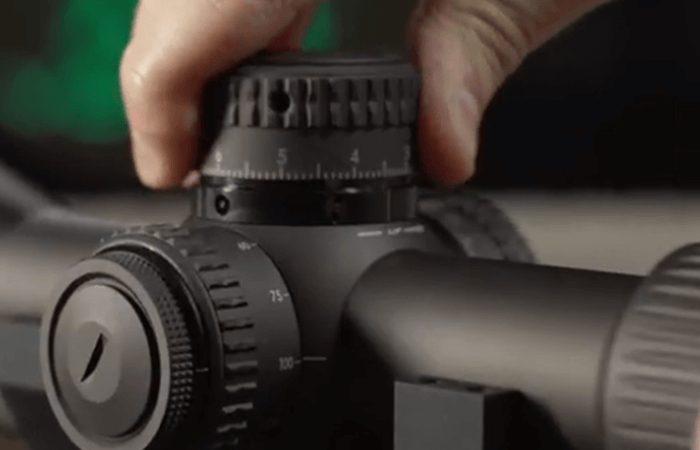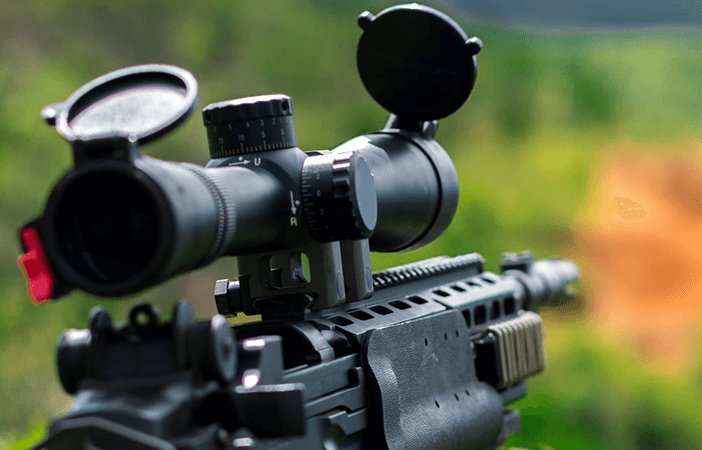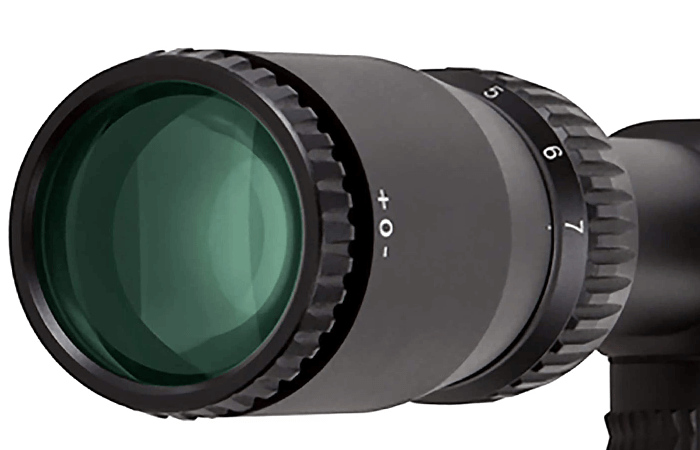If you’ve never purchased or used a rifle scope, it can be quite overwhelming. There are dozens of numbers, all of which affect how you’ll use and adjust the scope. Without proper knowledge of these numbers, you could end up missing your shots, not seeing the target, and having a bad experience.
The different numbers on a scope dictate its magnification, diameter, dimensions, and eye relief. The numbers on the scope’s adjustable knobs show its windage and elevation. Some rifle scopes include indicators for the minutes of angle, tube size, and weight, and many scopes have adjustable settings.
In this post, we’ll cover details about choosing the proper magnification and diameter numbers, why they matter, and how you can adjust your riflescope to suit your comfort.
We’ll also dive into information about every number found on the scope’s packaging, so you know what you’re getting yourself into.
What Are the Magnification Numbers on a Rifle Scope?
The magnification numbers are the most well-known and important parts of choosing a scope.
They show how far your rifle can zoom; for example, a scope labeled 3-9x40mm has a low end of 3x magnification and a high end of 9x magnification. It’s important to know how far you’re aiming when using a scope.
Below is a list of three factors you should know when reading the magnification numbers.
Magnification Determines How Far You Can See
OpticsPlanet explains the numbers before the millimeter dimensions often refer to the scope’s zooming capabilities
To put that into context: if you’re able to see a target that’s 90 feet (27.43 m) away, a 3x scope will make it look like it’s 30 feet (9.14 m) away, where using a 9x scope will make the target appear as if it was only 10 feet (3.05 m) away. There’s a wide range of magnification numbers used for scopes.
Some Scopes Have Adjustable Magnification
Plenty of rifle scopes have a static magnification, which means you can’t zoom anymore than it’s already magnified. A scope that’s labeled 3x40mm is magnified three times, as explained in the example above.
However, in this case, you can’t adjust it. That being said, many more scopes have a low and high-end setting, so find out what works best for you.
Bigger Numbers Aren’t Always Better
Many beginners often believe they should choose a scope with the highest magnification they can find. It’ll let them see further and clearer, right?
Contrary to what many believe, bigger isn’t always better. Zooming too far can result in various distortions that negatively impact the lens. Instead, choose a scope that lets you see clearly at a reasonable distance.
The magnification numbers are essential when using a rifle scope. Being able to zoom in and out is very useful, but it’s not always necessary if you’re satisfied with static, non-zooming scope.
Regardless of if your scope can zoom, there’s always a diameter number placed next to it. We’ll cover its meaning below.
What Are the Diameter Numbers on a Scope?

There are two types of scopes. Fixed power scope and variable power scope. Variable power rifle scopes offer the magnification range as the first two numbers. A fixed power scope shows a number, where the first is determined by what magnification you are trying to view at and the second appears as how large or small your lens is.
Using the previous example of a rifle scope labeled ‘3-9x40mm,’ we can reason that the 40mm is the diameter. A scope’s diameter affects almost everything related to its field of view (also known as FOV).
You’ve probably seen extremely wide or narrow scoops and wondered why people would prefer one over the other.
We’ll explain what the diameter changes below.
The Diameter Determines the Scope’s Width
Perhaps the most crucial detail of a scope’s diameter number is it determines the width. A typical riflescope varies between 32 to 50mm, though it can be slightly narrower or wider if you’d like it to be.
Long-range guns need a wider diameter because the field of view is reduced the further you zoom.
Diameter Numbers Are Static
The bad news about a scope’s diameter number is it can’t be adjusted. Static settings are unchangeable, so you’re stuck with the diameter as long as you use the scope.
For this reason (among others), it’s important to focus on the scope’s diameter when choosing it. Never settle for anything less, or you’ll risk a reduced field of view or eye comfort.
Diameter Numbers Are Often Based on Personal Preference
Despite the importance of choosing the correct size, many people believe a scope’s diameter should be a personal preference.
What works best for you might be terrible for someone else, and vice versa. Take an expert’s advice, but try your new scope at a practice range before attempting to use it in the field.
Once you’ve analyzed and chosen a scope based on its diameter, you can look through the remaining numbers.
However, it’s a good idea to know what determines the magnification and diameter. After all, why should one be better than the other? If you want to know the details, read on.
What Determines the Scope’s Magnification?

If you want to know why some rifle scopes aim further than others, you’re in the right place. Many factors influence a scope’s ability to aim, zoom, and so on. These numbers are crucial to the scope’s success, which means you should know where they come from.
Here’s a list of five reasons a scope has specific numbers:
#1. The lens’s curvature directly impacts its magnification qualities. One of the biggest factors is the objective lenses, which are placed on the front and back of the scope. They pull an image into the scope, adjust the light, and zoom it through the back where you look through it.
#2. Thicker and thinner objective lens offer varying magnification numbers. Low-end scopes often come with thin lenses, which is why they don’t zoom as far or last as long. Thick lenses aren’t always better, but they impact the zooming capabilities. Look for lenses coated with anti-glare or anti-fog coatings.
#3. A longer scope has a higher possibility of top-notch magnification. Long rifle scopes have more room to flip the image, letting them zoom further than a short scope. You’ve probably seen a massive scope on a sniper rifle and a much smaller scope on an M4 carbine. The size shows the user doesn’t need to look as far as the latter example.
#4. You can adjust the magnification with a ring on the scope. If you know how to mount a scope adjusting magnification can be done at any time. The vast majority of scopes zoom by twisting a ring that wraps around the scope. Gun University shows some scopes that let the entire scope twist (aside from the mounting equipment), while others use a thin ring that’s out of the way.
#5. Don’t forget to use the focuser. To clear the objective lens and analyze its zooming dimensions you can use the focuser. Zooming is nothing without optimal clarity. Use the focusing ring near the zooming ring to change the picture’s clarity. Flip it all the way to one side, then make slow adjustments until it’s crystal-clear.
As you can see, a scope is much more complicated on the inside than on the outside. A lot of work goes into making top-notch scopes perform as they should.
By bending the lenses and increasing the scope’s length, manufacturers can increase the scope’s magnification numbers. To increase its diameter, they only need to make each piece slightly wider.
How To Choose the Best Scope Numbers for Your Rifle
Now that you know the basics, it’s time to decide which scope is suitable for your gun. The numbers are quite possibly the most critical part of the process. Without the correct magnification and diameter, you won’t be able to see your target or use the scope as you should.
Follow this five-step process to choose the best scope numbers:
Determine How Far Away Your Target Will Be
If you’re aiming at a target that’s less than 100 yards (91.44 m) away, there’s no need to get a scope that’s bigger than 9x.
Too much magnification will make it hard to focus on the target since it limits your field of view. It will also make zeroing your scope time-consuming. Every little movement will shake the scope too much.
Consider Your Eye Comfort and Strain When Using a Scope
If you’re always leaving the range with a headache, you might need a wider or more magnified scope. Your eyes shouldn’t have to strain for you to see a vivid image through the objective lens. You should be able to relax and look downrange for a long time without headaches.
Leave Wiggle Room or Various Adjustments
When you’re getting a new scope, you should find something that has slightly wider adjustments than you need. For example, if you always use a 3x to 6x zoom, get a 3x to 9x zoom. Why not have the extra room to make adjustments if you want to aim further?
Choose the Proper Field of View for Your Scope
Don’t settle for a limited diameter in favor of a good magnification. You’ll risk straining your eyes and dealing with headaches, as mentioned above. Look down several scopes before making a decision, especially if you’ve never owned one.
Consider Exit Pupil Dimensions
Consider exit pupil dimensions when reviewing the scope’s numbers. The exit pupil dimensions refer to the amount of light exiting the scope and entering your eye.
If it’s too small, you won’t have a clear picture. If it’s too big, the scope might look warped. Aiming Expert shows the exit pupil should be a minimum of 2mm to 6mm.
Can the Scope’s Numbers Be Reduced?
Assuming you’ve purchased a scope and want to know if you can adjust the numbers, there are a few alterations possible.
However, none of them are beneficial, and many of them can be detrimental to your scope. It’s best to get a new scope if you’re uncomfortable with the numbers, especially the field of view provided by the scope’s diameter.
The following examples show what can affect a scopes numbers, clarity, and functionality:
Adjust Your Scope Anytime if Necessary
You can always adjust your scope within the provided parameters. If your scope has multiple magnifications, you can twist the previously mentioned ring to zoom in or out.
If the zooming capabilities are limited or stuck, you should get the scope inspected by a professional to free the mechanism.
Field of View Is Impossible to Adjust
The field of view is impossible to adjust. Unfortunately, you’re not able to make the lens wider or narrower. If you’re unhappy with the result, you’ll have to get a new rifle scope.
However, some people narrow the objective lens with tape and other makeshift attachments, but we don’t recommend this process.
Chromatic Aberration
Chromatic aberration can be a serious problem for old, damaged scopes. A scope without compensation for chromatic aberration can cause a rainbow-like effect.
This process happens when light hits lenses or water droplets, altering the light entering the scope. It worsens as you zoom the scope.
Magnification Affects Its Clarity and Dimness
The scope’s magnification affects its clarity and dimness. Further zooming typically makes a scope less clear, especially if you purchased a low-quality rifle scope.
The ambient lighting (whether you’re inside or outside) will also impact how well you can see through the scope-scopes designed for long-range aiming usually correct this issue.
You Can Never Change The Manufacturers’ Provided Number
You’ll need a new scope for anything outside of the manufacturer’s provided numbers. Whether you’re upset with the diameter, magnification, exit pupil distance, MOA, or anything else, there’s not much you can do to change your scope’s numbers. Scopes are made to be durable and unchangeable beyond their preset limits.
Related reading: How Fragile are Rifle Scopes?
Why Don’t Some Scopes Have Numbers?
If you have a new rifle scope or found one looking through an online seller, you might’ve noticed they don’t have numbers. Why would someone sell a scope without showing its capabilities?
While it’s frowned upon, there are a couple of reasons a scope might not have numbers listed on its exterior. Keep in mind every scope should have its specs on the packaging, though.
Non-zoomed scopes don’t need numbers. Many manufacturers don’t list the numbers on the scope if they don’t have a magnification.
Some rifle scopes (known as 1x scopes) don’t zoom in, which means they won’t have it listed on the exterior. However, it should be on the packaging. If you don’t find the specs on the packaging when buying a new scope, stay away from it.
They might have been removed by previous owners. Some people like painting over the numbers if they’re listed on the scope. This allows them to provide optimal camouflage, but it can be detrimental when choosing to sell it.
Always test the rifle scope and ask for a receipt, packing, or something that can verify its magnification and diameter before getting it.
Low-end scopes aren’t always labeled. Far too many companies sell cheap scopes without showing what they’re capable of. If you’re searching for scope and it’s not labeled, it’s not worth adding to your collection.
Additional Scope Lens Number Meanings

We’ve covered the basics, but some scopes list more details. You’ll find them below.
Eye Relief Numbers
Eye relief numbers show how far away your eye needs to be from the rifle scope. If your eye is too close, you’ll risk it bouncing back and hitting your face. If your eye is too far away, you’ll strain and cause headaches. Follow the recommended eye relief distance for the best results.
MOA Numbers
Minutes of Angle (also known as MOA) measures the angle per unit of distance. These aren’t on every scope, but they should be. MOA details how far the bullet will stray based on the distance. It should show how many centimeters or inches per 100 yards (91.44 m).
Exit Pupil Number
The exit pupil refers to the diameter of light traveling through the rifle scope. As shown earlier in the post, the exit pupil should be between 2mm to 9mm.
Scope’s Size, Weight Number
A scope’s magnification and objective lens diameter are usually listed on a manufacturer’s specification sheet. The scope’s tube size is often labeled, too. This often corresponds with its diameter, though some scopes have thick exterior shells for durability purposes.
The length, weight, width, magnification range, variable power, fixed power and maximum magnification are also on the box or rifle scope. Check the scope’s packaging or underside for this information.
What Does a Scope’s Knob Measurements Mean?
Almost every scope has knobs that account for elevation, windage, and focusing. These adjustments make a world of difference, especially when you’re zeroing the rifle scope for the first time.
A Scope’s Elevation Numbers
Adjusting the scope’s elevation numbers will make it go up or down based on the changes you make. The further you shoot, the more drops you’ll experience. It’s the primary component in long-range shooting.
A Scope’s Windage Numbers
Changing the scope’s windage will account for the wind blowing in either direction. If the shots are hitting too far to the left, you should adjust it to the right (or vice versa). You’ll likely have to change this number frequently if you live and hunt in a windy area.
Lens Focusing Numbers
Although not every scope has a numerical focusing system, every scope should come with a lens focuser. Change the focus by twisting the lens ring. If there are numbers, you can find the perfect setting and stick with it every time you use the scope.
Final Thoughts: What Do Different Numbers Mean in a Rifle Scope?
The numbers on your rifle scope affect its performance and your experience with it. Instead of aimlessly looking down the tube and hoping it works, you can pick the best scope dimensions that set you up for success.
A scope’s numbers might be confusing at first, but we’ve simplified everything to paint a clearer picture.
Remember, you can adjust most scope’s windage, elevation, focus, and zoom. Don’t shy away from switching things as you go. Zeroing in on scoping, hunting, and target practice takes time and countless adjustments to perfect.
Related Articles:
- Can I Use a Rifle Scope on Crossbow
- Why Are Rifle Scopes So Expensive
- What Is a Custom Turret and Do You Need One
- How To Tell if My Gun Sights Are Off
- How To Clean Microfiber Cloth for Rifle Scopes
- What Is a 30/30 Reticle on Rifle Scopes

